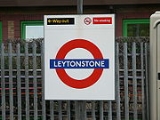
Signage systems
Encyclopedia
Signage systems are visually oriented information systems, consisting of signs, map
s, arrows, color codings systems, pictogram
s and different typographic
elements. Signage systems differ from other methods of information presentation because they are typically used to guide people's passage through the physical world; road signs on a highway, station identification signs in a subway and overhead signs in an airport are all common examples of signage systems. The act of following a signage system is known as wayfinding, waysigning or signposting.
While any collection of correlated signs can be considered a signage system, the term is typically used to refer to a group of signs with a coherent design and purpose. Frequently, significant effort is put into creating an intelligent presentation for a sign that takes into account scientific knowledge about humans' reactive capabilities to typefaces and colors. This research has produced a design aesthetic of certain fonts that are frequently used (especially humanist sans-serif designs like Frutiger
, which was created in 1969 for signage in Paris' Charles de Gaulle Airport.)
 One of the most commonly cited examples of a well-designed signage system is the London Underground
One of the most commonly cited examples of a well-designed signage system is the London Underground
. The Underground's station signs consist of a red roundel and a horizontal blue bar containing the station name. They are instantly recognizable to riders throughout London, are unlikely to be confused with other signage, and can be replicated throughout printed materials, stations, and street-level entrances to provide consistency throughout the entire system. The typeface used on the signs, New Johnston
, was designed in 1913 specifically for the Underground to provide readability at a distance.
Map
A map is a visual representation of an area—a symbolic depiction highlighting relationships between elements of that space such as objects, regions, and themes....
s, arrows, color codings systems, pictogram
Pictogram
A pictograph, also called pictogram or pictogramme is an ideogram that conveys its meaning through its pictorial resemblance to a physical object. Pictographs are often used in writing and graphic systems in which the characters are to considerable extent pictorial in appearance.Pictography is a...
s and different typographic
Typography
Typography is the art and technique of arranging type in order to make language visible. The arrangement of type involves the selection of typefaces, point size, line length, leading , adjusting the spaces between groups of letters and adjusting the space between pairs of letters...
elements. Signage systems differ from other methods of information presentation because they are typically used to guide people's passage through the physical world; road signs on a highway, station identification signs in a subway and overhead signs in an airport are all common examples of signage systems. The act of following a signage system is known as wayfinding, waysigning or signposting.
While any collection of correlated signs can be considered a signage system, the term is typically used to refer to a group of signs with a coherent design and purpose. Frequently, significant effort is put into creating an intelligent presentation for a sign that takes into account scientific knowledge about humans' reactive capabilities to typefaces and colors. This research has produced a design aesthetic of certain fonts that are frequently used (especially humanist sans-serif designs like Frutiger
Frutiger
Frutiger is a series of typefaces named after its designer, Adrian Frutiger. Initially available as a sans serif, it was later expanded to include ornamental and serif typefaces.-Distinctive characteristics:Characteristics of this typeface are:...
, which was created in 1969 for signage in Paris' Charles de Gaulle Airport.)
London Underground

London Underground
The London Underground is a rapid transit system serving a large part of Greater London and some parts of Buckinghamshire, Hertfordshire and Essex in England...
. The Underground's station signs consist of a red roundel and a horizontal blue bar containing the station name. They are instantly recognizable to riders throughout London, are unlikely to be confused with other signage, and can be replicated throughout printed materials, stations, and street-level entrances to provide consistency throughout the entire system. The typeface used on the signs, New Johnston
Johnston (typeface)
Johnston is a humanist sans-serif typeface designed by and named after Edward Johnston. It is well known for its use by Transport for London....
, was designed in 1913 specifically for the Underground to provide readability at a distance.

